七年级英语-名词单复数形式转换
- 格式:doc
- 大小:32.50 KB
- 文档页数:1
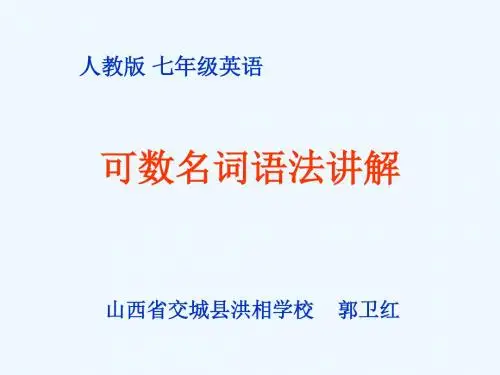
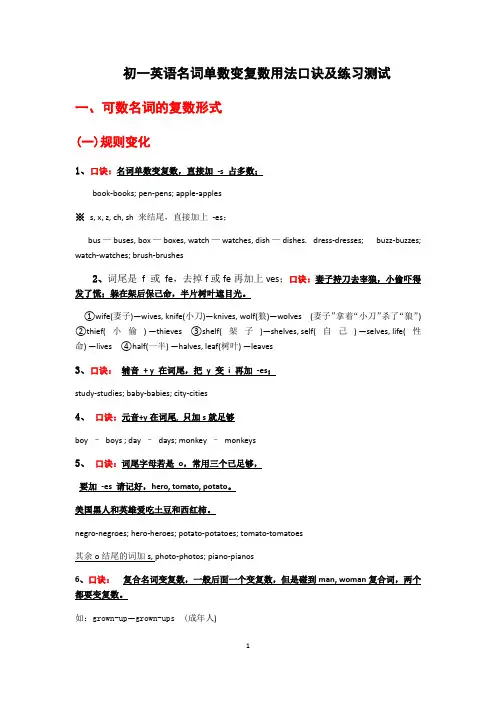
初一英语名词单数变复数用法口诀及练习测试一、可数名词的复数形式(一)规则变化1、口诀:名词单数变复数,直接加-s 占多数;book-books; pen-pens; apple-apples※s, x, z, ch, sh 来结尾,直接加上-es;bus—buses,box—boxes,watch—watches,dish—dishes. dress-dresses; buzz-buzzes; watch-watches; brush-brushes2、词尾是f 或fe,去掉f或fe再加上ves;口诀:妻子持刀去宰狼,小偷吓得发了慌;躲在架后保己命,半片树叶遮目光。
①wife(妻子)—wives,knife(小刀)—knives,wolf(狼)—wolves(妻子”拿着“小刀”杀了“狼”)②thief(小偷)—thieves③shelf(架子)—shelves,self(自己)—selves,life(性命)—lives④half(一半)—halves,leaf(树叶)—leaves3、口诀:辅音+ y 在词尾,把y 变i 再加-es;study-studies; baby-babies; city-cities4、口诀:元音+y在词尾, 只加s就足够boy –boys ; day –days; monkey –monkeys5、口诀:词尾字母若是o,常用三个已足够,要加-es 请记好,hero, tomato, potato。
美国黑人和英雄爱吃土豆和西红柿。
negro-negroes; hero-heroes; potato-potatoes; tomato-tomatoes其余o结尾的词加s, photo-photos; piano-pianos6、口诀:复合名词变复数,一般后面一个变复数,但是碰到man,woman复合词,两个都要变复数。
如:grown-up—grown-ups (成年人)man doctor—men doctors (男医生)(二) 不规则变化男人女人a 变e,鹅足牙oo 变ee;man-men; woman-women; goose-geese; foot-feet; tooth-teeth老鼠虱子也好记,ous 变ic;mouse-mice; louse-lice孩子加上ren,鱼鹿绵羊不用变child-children; fish; deer; sheepthis---these(这些)I --- we it/he/she--- they that -- those(那些)【说明】①man(男人)—men,woman(女人)—women,含有man,woman的合成词,其复数是把a变成e.如:policewoman, postman, f isherman等。

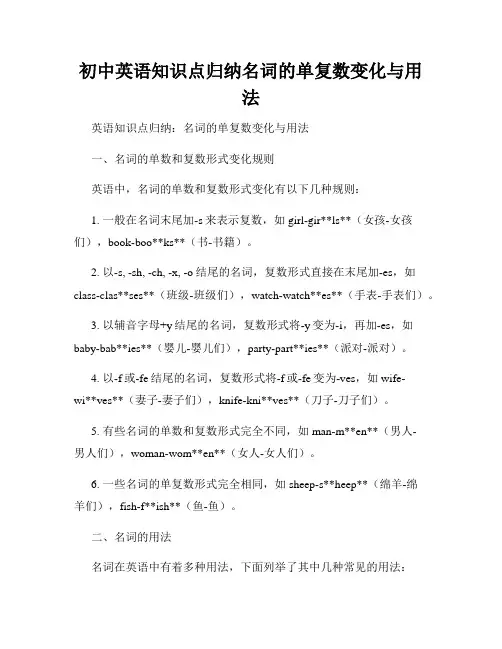
初中英语知识点归纳名词的单复数变化与用法英语知识点归纳:名词的单复数变化与用法一、名词的单数和复数形式变化规则英语中,名词的单数和复数形式变化有以下几种规则:1. 一般在名词末尾加-s来表示复数,如girl-gir**ls**(女孩-女孩们),book-boo**ks**(书-书籍)。
2. 以-s, -sh, -ch, -x, -o结尾的名词,复数形式直接在末尾加-es,如class-clas**ses**(班级-班级们),watch-watch**es**(手表-手表们)。
3. 以辅音字母+y结尾的名词,复数形式将-y变为-i,再加-es,如baby-bab**ies**(婴儿-婴儿们),party-part**ies**(派对-派对)。
4. 以-f或-fe结尾的名词,复数形式将-f或-fe变为-ves,如wife-wi**ves**(妻子-妻子们),knife-kni**ves**(刀子-刀子们)。
5. 有些名词的单数和复数形式完全不同,如man-m**en**(男人-男人们),woman-wom**en**(女人-女人们)。
6. 一些名词的单复数形式完全相同,如sheep-s**heep**(绵羊-绵羊们),fish-f**ish**(鱼-鱼)。
二、名词的用法名词在英语中有着多种用法,下面列举了其中几种常见的用法:1. 主语:名词可以作为句子的主语,如"**Cats** are my favorite animals."(猫是我最喜欢的动物)。
2. 宾语:名词可以作为句子的宾语,接受动作的影响,如"I love **dogs**."(我喜欢狗)。
3. 定语:名词可以作为另一个名词的定语,用来限定其意义,如"**Book** store"(书店)。
4. 表语:名词可以作为系动词的表语,说明主语的身份、性质等,如"The girl is a **student**."(这个女孩是一名学生)。
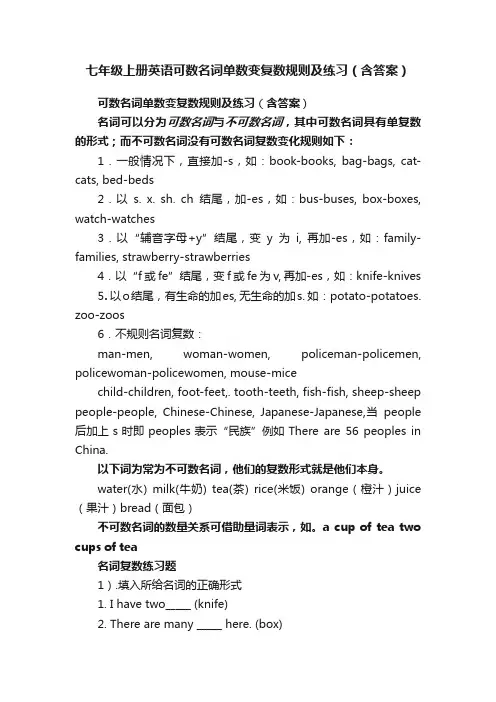
七年级上册英语可数名词单数变复数规则及练习(含答案)可数名词单数变复数规则及练习(含答案)名词可以分为可数名词与不可数名词,其中可数名词具有单复数的形式;而不可数名词没有可数名词复数变化规则如下:1.一般情况下,直接加-s,如:book-books, bag-bags, cat-cats, bed-beds2.以s. x. sh. ch结尾,加-es,如:bus-buses, box-boxes, watch-watches3.以“辅音字母+y”结尾,变y为i, 再加-es,如:family-families, strawberry-strawberries4.以“f或fe”结尾,变f或fe为v, 再加-es,如:knife-knives5.以o结尾,有生命的加es, 无生命的加s. 如:potato-potatoes. zoo-zoos6.不规则名词复数:man-men, woman-women, policeman-policemen, policewoman-policewomen, mouse-micechild-children, foot-feet,. tooth-teeth, fish-fish, sheep-sheep people-people, Chinese-Chinese, Japanese-Japanese,当people 后加上s时即peoples表示“民族”例如There are 56 peoples in China.以下词为常为不可数名词,他们的复数形式就是他们本身。
water(水) milk(牛奶) tea(茶) rice(米饭) orange(橙汁)juice (果汁)bread(面包)不可数名词的数量关系可借助量词表示,如。
a cup of tea two cups of tea名词复数练习题1).填入所给名词的正确形式1. I have two_____ (knife)2. There are many _____ here. (box)3. There are many _____ on the road. (bus)4. A few ____boys_ are drawing on the wall. (boy)5. The _childen____ are playing football now. (child)2)选择填空1. They come from different ______A. countryB. countriesC. a countryD. countrys2. How many ______ do you see in the picture?A. tomatosB. tomatoesC. tomatoD. the tomato3. There are some ______ in these _______.A.knifes…pencil-boxesB.knives…pencils-boxC.knives…pencil-boxD.knives…pencils-boxes4. There is no ______ in the plate.A. applesB. orangesC. riceD. eggs5. _______ are good for our health.A. TomatosB. TomatoesC. Tomato6. I like to eat cake with ______.A. cherriesB. cherryC.cherrys7. ______ and ______ are not friends.A. Foxs…wolfsB.Foxes wolfsC.Foxes…wolves8. Do you want to drink much ?A.a milkkks9. This is room. It’s very bi g.A.Lily and Lucy’sB.Lily’s and Lucy’sC.Lily’s and Lucy10. Do you want some for supper?A、a potatoB、potatoesC、potatos11. In autumn,you can see a lot of on the ground.A、leafB、leafsC、leaves12. My sister has two . One is old,the other is new.A、a watchB、watchsC、watches13.There on the wall .They are very beautiful.A. are photoesB. are photosC. is a photoD. is photos14. That’a art book.A. anB. aC. the D are15. There two in the box.A. is watchB. are watchesC. are watchD. is watches3)请用括号中名词的复数形式填空1. Look at those _______. (child)2. I can see a __________ standing near the door. (policeman) 3. Do you want some ________ for dinner? (potato)4.In autumn, you can see a lot of _______ on the ground.(leaf)5. He has two _______.One is blue , the other is yellow.( box) 6. Two ________ live in this building .( family )4)选择正确的词形1. How many (radioes, radios) can you see?2. There are 36 (boys, boies) in my class.3. Look at those (sheeps, sheep).4.I don’t want (a, an) old cup.5. Give me that (box, boxes), please.5)将以下单复数句进行转换1. This is a knife.___________________________________2. That is a tomato.___________________________________3. That child is very good.___________________________________4 .These are mice.___________________________________5. Those are children.___________________________________答案1.knives boxes buses boys children2.BBDCB ACBAB CCBAB3.Children policeman potatoes leaves boxes families4.Radios boys sheep an5.These are knives.Those are tomatoes.Those children are very good.This is rice.That is child.。


七年级下册英语第六单元不规则变化的可数名词复数
可数名词单数变复数的不规则变化有如下几种变化:
man / men 男人woman / women 女人
child / children 小孩tooth / teeth 牙齿
foot / feet 脚goose / geese 鹅
mouse / mice 老鼠ox / oxen 公牛
【注】(1) 一些以man, woman 结尾的合成词,在构成复数时与man, woman 的变化形式相同,如:policeman / policemen(警察),gentleman / gentlemen(绅士),Englishman / Englishmen (英国人),等等。
但是human(人),German(德国人)不是合成词,其复数不能仿man 的变化规律,而是按规则变化,即用humans, Germans。
(2) foot表示“英尺”时,其复数可以有两种形式feet / foot,如:He is about six feet [foot] tall. 他大约6英尺高。
2. 单数与复数同形的名词。
常见的主要的有:
sheep 绵羊fish 鱼
deer 鹿Chinese 中国人
Japanese 日本人Portuguese 葡萄牙人
Swiss 瑞士人aircraft 飞行器
means 方法series 系列
head (牛等的)头数works 工厂
【注】fish 有时也用fishes 这样的复数形式,尤其是表示种类时;head 若不是表示牲口的“头数”,而是表示“人的头”或“人数”,则要用heads 这样的复数形式。

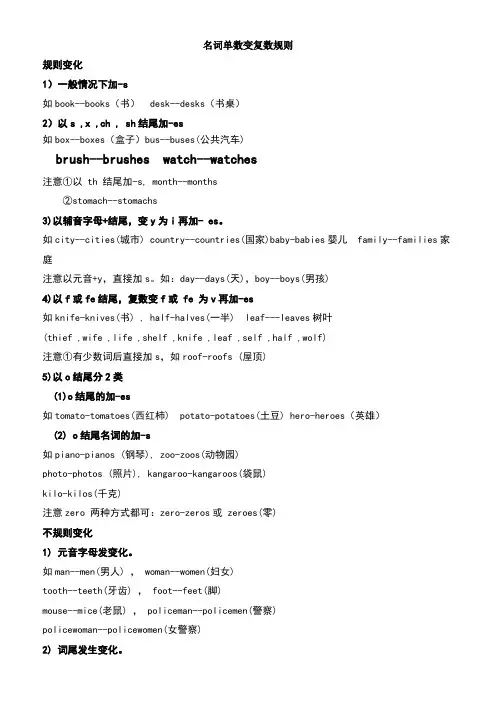
名词单数变复数规则规则变化1)一般情况下加-s如book--books(书) desk--desks(书桌)2)以s ,x ,ch , sh结尾加-es如box--boxes(盒子)bus--buses(公共汽车)brush--brushes watch--watches注意①以 th 结尾加-s, month--months②stomach--stomachs3)以辅音字母+结尾,变y为i再加- es。
如city--cities(城市) country--countries(国家)baby-babies婴儿 family--families家庭注意以元音+y,直接加s。
如:day--days(天),boy--boys(男孩)4)以f或fe结尾,复数变f或 fe 为v再加-es如knife-knives(书) , half-halves(一半) leaf---leaves树叶(thief ,wife ,life ,shelf ,knife ,leaf ,self ,half ,wolf)注意①有少数词后直接加s,如roof-roofs (屋顶)5)以o结尾分2类(1)o结尾的加-es如tomato-tomatoes(西红杮) potato-potatoes(土豆) hero-heroes(英雄)(2) o结尾名词的加-s如piano-pianos (钢琴), zoo-zoos(动物园)photo-photos (照片), kangaroo-kangaroos(袋鼠)kilo-kilos(千克)注意zero 两种方式都可:zero-zeros或 zeroes(零)不规则变化1) 元音字母发变化。
如man--men(男人) , woman--women(妇女)tooth--teeth(牙齿) , foot--feet(脚)mouse--mice(老鼠) , policeman--policemen(警察)policewoman--policewomen(女警察)2) 词尾发生变化。
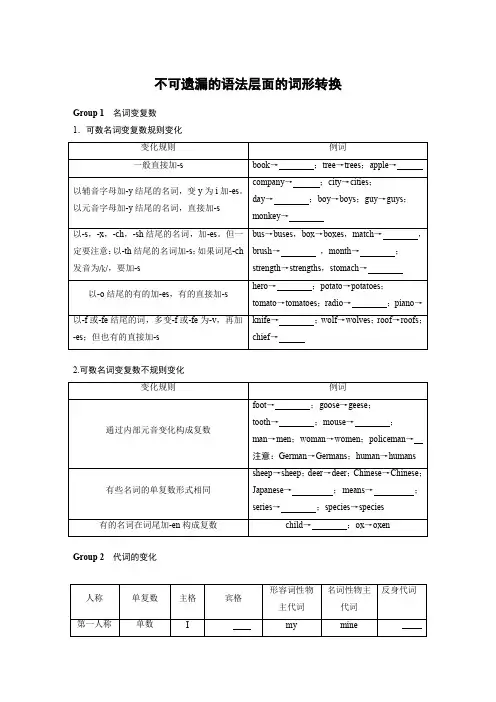
不可遗漏的语法层面的词形转换Group 1名词变复数1.可数名词变复数规则变化2.可数名词变复数不规则变化Group 2代词的变化Group 3形容词/副词变比较级和最高级1.规则变化注意:(1)少部分双音节词是以er,y,ow和le结尾的单词,直接加er,est或者r,st,如:clever,early,yellow,narrow,simple等。
(2)下列形容词没有比较级和最高级(即表示“最高程度”或“绝对状态”的形容词和副词没有比较级和最高级),如:empty;wrong;perfect;unique;extreme;excellent;favourite;true;right;correct等。
2.不规则变化Group 4动词变单数第三人称,过去式/过去分词和现在分词Group 5数词的变化1.基数词2.序数词3.分数参考答案Group 11.books apples companies days monkeys matches brushes months stomachs heroesradios pianos knives chiefs2.feet teeth mice policemen Japanese meansseries childrenGroup 2me myself we ours yourself you yours hisher its itself them theirsGroup 31.taller tallest shorter shortest later latest easier easiest heavier heaviest thinner thinnest bigger biggest more beautiful most beautiful more serious most serious more boring most boring more tired most tired2.better worst more least farther furthest elder oldestGroup 4writes finishes mixes goes cries hopedadmitted carried reading having runningGroup 51.two four six eight ten twelve fourteen fifteen eighteen forty ninety 2.second fourth ninth twelfth ninetieth twentythird3.two thirds two and three fifths。
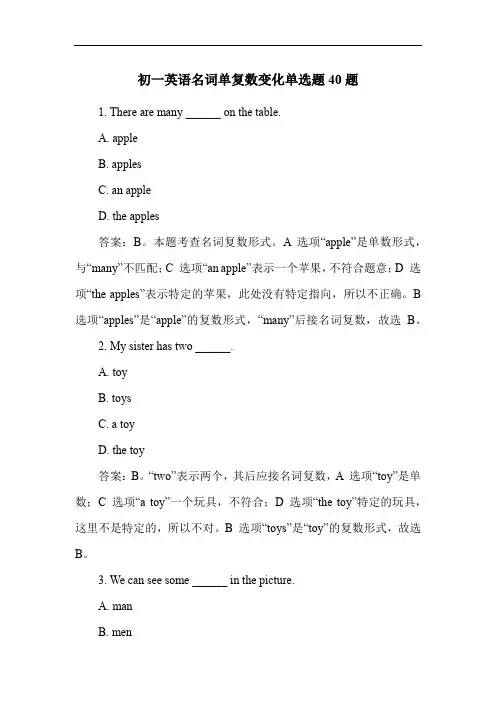
初一英语名词单复数变化单选题40题1. There are many ______ on the table.A. appleB. applesC. an appleD. the apples答案:B。
本题考查名词复数形式。
A 选项“apple”是单数形式,与“many”不匹配;C 选项“an apple”表示一个苹果,不符合题意;D 选项“the apples”表示特定的苹果,此处没有特定指向,所以不正确。
B 选项“apples”是“apple”的复数形式,“many”后接名词复数,故选B。
2. My sister has two ______.A. toyB. toysC. a toyD. the toy答案:B。
“two”表示两个,其后应接名词复数,A 选项“toy”是单数;C 选项“a toy”一个玩具,不符合;D 选项“the toy”特定的玩具,这里不是特定的,所以不对。
B 选项“toys”是“toy”的复数形式,故选B。
3. We can see some ______ in the picture.A. manB. menD. the man答案:B。
“some”一些,后接名词复数,A 选项“man”是单数;C 选项“a man”一个男人,不符合;D 选项“the man”特定的男人,不符合语境。
B 选项“men”是“man”的复数形式,故选B。
4. There is a ______ in the room.A. boxB. boxesC. an boxD. the box答案:A。
“is”是单数形式,其后接名词单数,B 选项“boxes”是复数;C 选项“an box”表述错误,应为“a box”;D 选项“the box”特定的盒子,这里没有特定指向。
A 选项“box”是单数形式,故选A。
5. I have three ______.A. penB. pensC. a penD. the pen答案:B。
七年级英语上册语法点五——名词单复数变化一、绝大多数的可数名词的复数形式,是在该词末尾加上后辍-s。
读音变化:结尾是清辅音读[s],结尾是浊辅音或元音读[z]。
例:friend→friends; cat→cats; style→styles; sport→sports; piece→pieces二、凡是以s、z、x、ch、sh结尾的词,在该词末尾加上后辍-es构成复数。
读音变化:统一加读[iz]。
例:bus→buses; quiz→quizzes; fox→foxes; match→matches; flash→flashes三、以辅音字母+y结尾的名词,将y改变为i,再加-es。
读音变化:加读[z]。
例:candy→candies; daisy→daisies; fairy→fairies; lady→ladies; story→stories四、以-o结尾的名词,如果不是外来词或缩写,就加-es,否则加-s构成复数。
读音变化:加读[z]。
例:tomato→tomatoes; potato→potatoes; torpedo→torpedoes; bingo→bingoes反例:silo→silos; piano→pianos(外来词); photo→photos; macro→macros(缩写词)五、以-f或-fe结尾的名词,多为将-f或-fe改变为-ves,但有例外。
读音变化:尾音[f]改读[vz]。
例:knife→knives; life→lives; leaf→leaves; staff→staves; scarf→scarves反例:roof→roofs六、以-us结尾的名词(多为外来词),通常将-us改变为-i构成复数。
读音变化:尾音[Es]改读[ai],其中[kEs]要改读为[sai],[gEs]要改读为[dVai]。
例:fungus→fungi; abacus→abaci; focus→foci; cactus→cacti; cestus→cesti七、以-is结尾的名词,通常将-is改变为-es。
10 名词单复数第一部分名词相关语法知识梳理名词复数形式的规则变化:1、一般情况下在词尾加-S book—books pen—pens2、以-s /-X /-ch /-sh结尾的名词在词尾加-es box—boxes bus-buses3、以辅音字母加-y结尾的单词,要变y为i,再加-es family-families baby-babies(以元音字母加-Y结尾的单词直接加-s;boy一boys key一keys)4、以f或fe结尾的词,多数把f或fe变为v,再加一es leaf-leaves knife…knives5、以o结尾的词,有生命的加-es,无生命的加-s tomato-tomatoes potato---potatoes zoo-zoos photo---photos名词复数形式的特殊变化:1 .改变中间元音字母,如:man----men woman----women foot--feet2、改变词尾字母,如:child---children3.单、复数形式相同,如:fish…fish , sheep…sheep , deer…deer名词所有格1、表示有生命的人或物的名词所有格形式,一般用's表示。
一般在单数名词的词尾加's,如:Chen Jie’s mother.2、以s结尾的复数名词只加',不以s结尾的复数名词要加's, 如:The students’bags 、The children's presents3、表两人及以上分别拥有,分别加’s,如果共同拥有,只将最后一个变所有格第二部分名词单复数专项训练(含解析)一、单项选择1.—Mum, what would you like to buy for supper today?—We need to buy three ________.A.kilo of potatoes B.kilos of potato C.kilos of potatoes D.kilo of potato2.There are thirty-eight ________ in our school.A.woman teachers B.women teachers C.women teacher D.woman teacher3.Billy goes to the supermarket to buy two ________ for dinner every Saturday morning.A.meat B.kilo of meat C.kilos of meat D.kilos meat 4.The little boy is crying because he lost(掉了)his two ________ in his mouth.A.tooth B.tooths C.toothes D.teeth5.We need to buy two _________ for supper today.A.kilo of tomatoes B.kilo of tomatos C.kilos of tomatoes D.kilos of tomatos 6.—Is there anything I can do for you, sir?—I’d like two ________. We all like them.A.bowls of rices B.boxes of apples C.kilos of porks D.bottles of oranges 7.We need to buy some ________ and two ________ meat for dinner this evening. A.potato; kilos B.potatoes; kiloes C.potatoes; kilos D.potatos; kilos 8.They often take _________, and they do eye _________ every day.A.exercise; exercises B.exercises; exercisesC.exercise; exercise D.exercises; exercise9.The children have ________ in the park on Sunday afternoon.A.a lot of fun B.lots of funs C.a lot fun D.lot of funs 10.The little girl has ________.A.a long hair B.long hair C.black hairs D.long hairs 11.All the ________ are from ________. They are very kind to others.A.men doctors; American B.men doctors; AmericaC.man doctors; American D.man doctors; America12.—What would you like?—I’d like ________.A.two bottles of oranges B.two baskets of orangeC.two bottle of orange juice D.two bottles of orange juice13.Would you like some ________, please?A.bread B.mango C.noodle D.egg14.Miss Li has long black hair and ________.A.wear glasses B.wears glasses C.wear glass D.wears glass 15.— ________ your ________ long or short?— I have short hair.A.Is;hair B.Are;hairs C.Does;hair D.Do;hairs16.Would you like __________ for lunch?A.some chickens B.any chickens C.some chicken D.any chicken17.—Tomorrow is Winter Solstice (冬至). People usually eat dumplings.—Let’s make some. We need to buy _______ and some vegetables.A.two kilos of meat B.two kiloes of meatC.two kilo of meat D.two kilos of meats18.—Come on, children! Help yourselves to some ________ if you like.—Thank you, Mom.A.fish and potato B.fishes and potatoes C.fish and potatoes D.fishes and potato19.—I like those ________ in our classroom. What’s your classroom like?—It’s clean and bright. And there ________a map of China on the wall.A.photos; are B.photo; is C.photo; are D.photos; is20.There is a ________ shop and two ________ shops not far away from my school.A.sport; shoes B.sports; shoes C.sport; shoe D.sports; shoe二、用所给单词的正确形式填空21.I clean my ________ three times every day. (tooth)22.We never forget these ________ (hero) names like Yang Gensi in the Battle of Lake Changjin (长津湖战役). 23.Tom is ill, so we should send him to ________ (child) Hospital at once.24.________ like Yang Qian become our heroes after 2020 Tokyo Olympics.(play)25.Kobe Bryant, one of the top basketball ________ (play), died in an accident in 2020.26.The ________ start to turn green in spring. (leaf)27.Many actors from different _____ (company) join in the movie.28.The scarf must be one of these ________ (lady). They just talked here.29.I will cut the apple into ________ (half) and let’s share them.30.The students come from different ________ . (country)参考答案:1.C【详解】句意:——妈妈,今天晚饭你想买什么?——我们需要买三公斤土豆。
一、绝大多数的可数名词的复数形式,是在该词末尾加上后辍-s。
读音变化:结尾是清辅音读[s],结尾是浊辅音或元音读[z]。
例:friend→friends; cat→cats; style→styles; sport→sports; piece→pieces二、凡是以s、z、x、ch、sh结尾的词,在该词末尾加上后辍-es构成复数。
读音变化:统一加读[iz]。
例:bus→buses; quiz→quizzes; fox→foxes; match→matches; flash→flashes三、以辅音字母+y结尾的名词,将y改变为i,再加-es。
读音变化:加读[z]。
例:candy→candies; daisy→daisies; fairy→fairies; lady→ladies; story→stories四、以-o结尾的名词,如果不是外来词或缩写,就加-es,否则加-s构成复数。
读音变化:加读[z]。
例:tomato→tomatoes; potato→potatoes; torpedo→torpedoes; bingo→bingoes 反例:silo→silos; piano→pianos(外来词); photo→photos; macro→macros(缩写词)五、以-f或-fe结尾的名词,多为将-f或-fe改变为-ves,但有例外。
读音变化:尾音[f]改读[vz]。
例:knife→knives; life→lives; leaf→leaves; staff→staves; scarf→scarves反例:roof→roofs六、以-us结尾的名词(多为外来词),通常将-us改变为-i构成复数。
读音变化:尾音[Es]改读[ai],其中[kEs]要改读为[sai],[gEs]要改读为[dVai]。
例:fungus→fungi; abacus→abaci; focus→foci; cactus→cacti; cestus→cesti七、以-is结尾的名词,通常将-is改变为-es。
英语基础知识积累-名词由单数形式变成复数形式的规则1一般的名词词尾加 -s如:book → booksroom → roomshouse → housesday → days2以 s,ss,ch,sh,x 结尾的名词,在词尾加 -es 如:bus → busesglass → glasseswatch → watchesdish → dishesbox → boxes3以"辅音字母+y"结尾的名词,要先将 y 改为 i 再加 -es 如:city → citiesbody → bodiesfactory → factories4以 f/fe 结尾的名词,要将 f/fe 改为 v 再加-es如:half → halvesleaf → leavesknife → kniveswife → wives5特例 [悄悄话:特例常常考,规律要记住] 1. man → menwoman → womenpoliceman → policemen(规律:man → men)2. tomato → tomatoespotato → potatoes[规律:有生命的加-es,无生命的加-s ]3. foot → feettooth → teeth[规律:oo变成ee]4. sheep,Chinese,Japanese 单、复数同形。
[规律:单复同形:变复数时词形不可变]5. people 表示复数意义,要求谓语动词用复数;people 加上-s以后,peoples通常指“多个民族”。
[规律:集体名词只做复数:people很特殊,谓语用复数]。
英语中【可数名词】:“单数形式”变“复数形式”
英语中的可数名词,大多都有单数和复数两种形式,
单数形式变成复数形式,几种主要方式是:
1. 在名词后直接加-s,如:
a book →books a cat →cats
2. 以s, x, ch, sh结尾的名词加-es构成复数,如:
a bus → buses a box → boxes a watch → watches a dish →dishes
3. 以“辅音字母+ y”结尾的名词,构成复数时,需将y改为i,然后加复数词尾-es,如:
a dictionary → dictionaries a strawberry → strawberries
a family → families a country → countries
★注意:以元音字母加y结尾的,加-s:
a boy → boys a key → keys
4. 以f或fe结尾的名词构成复数时,一般改f为v,再加-es,如:
a knife →knives a leaf →eaves
★注意:但也有例外,例外的词有:
a roof →roofs a cliff →cliffs 等等
5. 以元音字母o结尾的名词, 一般加-es词尾构成复数,如:(有生命的名词)。
[口诀] 黑人英雄爱吃西红柿和马铃薯,有意思(es)
a negro →negroes a hero →heroes
a tomato →tomatoes a potato →potatoes
★注意:但也有例外,加-s,例外的词有:(无生命的名词)
a photo →photos a piano →pianos a radio →radios 等等
6. 有些名词复数有不规则变化,如:
a man →men a woman →women a tooth →teeth
a foot →feet a child →children a mouse →mice
7. 有些名词单复数形式相同,如:
a sheep →sheep a deer →deer
名词复数形式还有一些其它情况,请同学们在阅读和学习过程中不断丰富,逐步掌握。